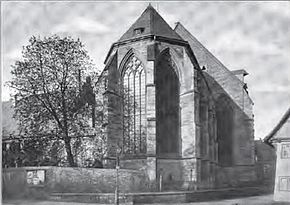Franciscan monastery Soest
The Franciscan monastery in Soest (after the color of the medal Habits of Franciscans called "gray monastery") was founded in 1233 and existed until 1814. The gothic monastery church Neu-St. Thomas (as opposed to the nearby Alt St. Thomas Church ) now serves as the Protestant parish church.
history
The initiative for the establishment of the Franciscan order founded in 1210 ( Ordo fratrum minorum , order of the Friars Minor or Minorites) came from the Archbishop of Cologne, Heinrich von Molenark , who had asked the Provincial Chapter of the Saxon Province of the Franciscans in Magdeburg to establish it in Soest. The institution then belonged to the Cologne Order Province founded in 1239 . The monastery is the first monastery to be founded by the Friars Minor in Westphalia.
In 1259, at the time of Archbishop Konrad von Hochstaden , the construction of the church and convent buildings was funded by an indulgence . At the same time, the archbishop allowed the friars in Soest to preach and to hear confession . As a result, the monastery benefited from further indulgences from bishops and popes. The money was used primarily for construction work. This lasted essentially until 1290. Later on, the order received many alms from the townspeople.
The monastery offices were the guardian as superior of the convent, the vice guardian as his deputy and the lecturer . Procurators outside the monastery administered the property of the brothers, who according to their rule of the order were not allowed to own property themselves. In Soest, the Franciscans mainly looked after the urban lower classes. They cared for the sick, the lepers and the dying.
Like the Dominican monastery in Soest , the existence of the Franciscans was threatened after the introduction of the Reformation in 1531/32. The brothers temporarily went to Werl , but soon returned to Soest. They then took care of the pastoral care of the Catholic minority in the city.
In the 18th century the economic situation of the monastery deteriorated. After all, in 1768 the convent still consisted of 29 members. When it was abolished in 1814 as a result of secularization , however, only eight brothers lived in Soest. In the following period (1819–1881) the teachers 'seminar for Westphalia was located in the buildings of the Minorite monastery and from 1892 to 1999 the preachers' seminar of the Protestant Church of Westphalia. The buildings with the adjoining former Minorite Church, today Neu-St. Thomä, were badly damaged in bombing raids on December 6, 1944 and March 7, 1945. The holdings of the monastery archive are now in the Münster State Archive .
Monastery church
The Gothic monastery church, which was built from 1259, is closely related to the building history of Cologne Cathedral , thanks to its support from the archbishops , whose architectural forms, especially in the four-lane tracery windows , are precisely copied. Its choir, consecrated in 1292, has three bays with a 5/8 end, a sacristy is built on the south side . The nave , which was completed when the church was consecrated in 1343 , is a three-aisled, four-bay hall church , the interior of which appears spacious and flooded with light thanks to its wide spacing between pillars. You can also find the shape of the hall space in the double aisles of Cologne Cathedral.
In 1851 the Prussian state acquired the secularized monastery church; since then it has served as a parish church for the evangelical Thomas parish. The church, which was badly damaged in World War II , was rebuilt between 1956 and 1966. In addition to church services, organ concerts and other performances are also held here today.
Organs
The organ, built in 1970 by the Alexander Schuke Potsdam Orgelbau company (then VEB Potsdamer Schuke-Orgelbau), has 37 registers distributed across 3 manuals and pedal , with slide chests , mechanical game and electrical register action . In 1995 the typesetting system was expanded to 256 storage locations.
Disposition of the Schuke organ (Op. 410) from 1970:
|
|
|
|
||||||||||||||||||||||||||||||||||||||||||||||||||||||||||||||||||||||||||||||||||||||||||
the breastwork is swellable
-
Pairing :
- Normal coupling: II / I, III / I, I / P, II / P, III / P
-
Playing aids :
- 256-fold setting system with sequencer up / down for hand and foot
- Tutti, tongue holder
literature
- Markus Hunecke OFM: The Neu-St.-Thomäkirche in Soest and its Franciscan past. Börde-Verlag, Werl 2003, ISBN 3-9807740-8-2 .
- Edeltraud Klueting : The monastery landscape of the Duchy of Westphalia in the High Middle Ages. In: Harm Klueting (Ed.): The Duchy of Westphalia. Volume 1: The Electorate of Cologne Duchy of Westphalia from the beginnings of Cologne rule in southern Westphalia to secularization in 1803. Aschendorff, Münster 2009, ISBN 978-3-402-12827-5 , pp. 93-97.
- Marga Koske : Soest - Minorites . In: Karl Hengst (Hrsg.): Westfälisches Klosterbuch. Part 2: Münster - Zwillbrock. Aschendorff, Münster 1994, ISBN 3-402-06888-5 , pp. 366-370 ( sources and research on church and religious history 2, publications of the Historical Commission for Westphalia 44).
- Werner M. Ruschke: Seminary in Soest 1892–1999. A piece of city history comes to an end! In: Soester magazine. 11, 1999, ISSN 0176-3946 , pp. 116-134.
- Hubertus Schwartz : Soest in his monuments. Third volume: Gothic churches (= Soester Scientific Contributions, Volume 16). 2nd unchanged edition. Westfälische Verlagsbuchhandlung Mocker & Jahn, Soest 1979, pp. 27–56.
Web links
Coordinates: 51 ° 34 ′ 9.2 ″ N , 8 ° 6 ′ 46 ″ E
swell
- ↑ Werner M. Ruschke: Preachers' seminar in Soest 1892–1999 - a piece of city history comes to an end! In: Soester magazine. 11 1999, p. 117.
- ↑ Johann Josef Böker : Gothic sacral architecture in Soest . In: Heinz-Dieter Heimann (Ed.): Soest: History of the City , Vol. 2: The world of citizens: Politics, society and culture in the late medieval Soest (Soest contributions 53). Mocker & Jahn, Soest 1996, pp. 472-476.

